family

 Battery Spencer was a reinforced concrete Endicott Period 12-inch gun battery, which was located on Fort Baker, Lime Point, Marin County, California. The structure still exists today and is a favorite tourist attraction. The battery was named on Feb 14, 1902, after Major General Joseph Spencer, who was a Revolutionary War hero. Spencer died on January 13, 1789. Construction on the battery began in 1893, and it was completed in 1897. Following its completion, it was transferred to the Coast Artillery for use on September 24, 1897, at a total cost of $110,352.70. It was deactivated in 1942 during World War II.
Battery Spencer was a reinforced concrete Endicott Period 12-inch gun battery, which was located on Fort Baker, Lime Point, Marin County, California. The structure still exists today and is a favorite tourist attraction. The battery was named on Feb 14, 1902, after Major General Joseph Spencer, who was a Revolutionary War hero. Spencer died on January 13, 1789. Construction on the battery began in 1893, and it was completed in 1897. Following its completion, it was transferred to the Coast Artillery for use on September 24, 1897, at a total cost of $110,352.70. It was deactivated in 1942 during World War II.
The battery was originally part of the Harbor Defense of San Francisco. The harbor was likely one of the most vulnerable entrances to San Fransisco, and in the early days of the country, when radar didn’t exist, it was hard to tell if an enemy was sneaking into the harbor, especially a submarine. Battery Spencer was a concrete coastal gun battery with three M1888 12-inch guns mounted on long range Barbette M1892 carriages. It was constructed on top of the five front emplacements of Battery Ridge. Back in the early 1900s, Battery Spencer was one of the main protection points for the San Francisco Bay. It featured multiple lookout points that were operated by the military and a few buildings for housing the generators and shells. It was used on and off until World War II when a lot of it was scrapped for war efforts.
The guns were mounted on 3 emplacements. Emplacements #1 and #2 were separated by a magazine with two shell rooms, a powder room, and a shell hoist room. Emplacement #3 had its own shell room, powder room, and hoist room. Spencer Battery was a two-story battery with the magazines on the lower level and the gun emplacements on the upper level. The missiles, or more likely cannon balls at first, were originally moved from the magazine level to the loading level with hand powered projectile hoists. In 1908, the hand powered hoists were replaced with electric Taylor-Raymond front delivery hoists. The new hoists were put into service on September 30, 1908. There were no powder hoists at Battery Spencer, meaning that gun powder had to be moved by hand.
Along the access road that runs north of Emplacement #1, was the BC Post and a separate building that had four rooms. The rooms consisted of a CO room, a guard room, an oil room, and a large 12′ by 43′ plotting room. All of these were used to plan any defensive action taken by the soldiers stationed at Battery Spencer. Two other buildings across the road completed the battery. One housed the tools and rammers, the other a latrine building with separate facilities for officers and enlisted. In 1910 the BC post and the plotting room were remodeled and updated. The work was accepted for service on August 5, 1910, at a cost of $1680.68.
When the United States entered World War I, it was decided that the large caliber coastal defense gun tubes should be removed from coastal batteries and sent into service in Europe. First, they were sent to arsenals for modification and mounting on mobile carriages, both wheeled and railroad. Strangely, most of the removed gun tubes never made it to Europe. Many were either remounted at the batteries or remained at the arsenals until needed elsewhere. One gun was removed from Battery Spencer emplacement #3 in 1918 and sent to Battery Chester at Fort Miley. The gun at Battery Spencer was never replaced, and the emplacement was considered abandoned. The carriage remained in place until it was ordered salvaged on January 10, 1927. World War II brought the first large scale scrap drive, and the remaining two guns and carriages were ordered scrapped on November 19, 1942. 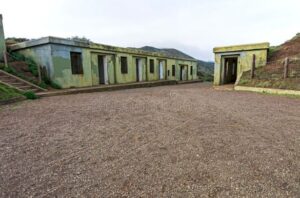
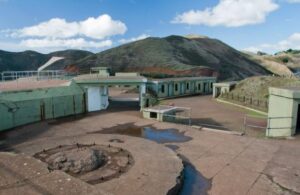
These days Battery Spencer is part of the Golden Gate Recreation Area (GGNRA) administered by the National Park Service. It is a favorite historical attraction, even though no period guns or carriages are in place. The site is also one of the very best views of the Golden Gate Bridge and San Francisco.
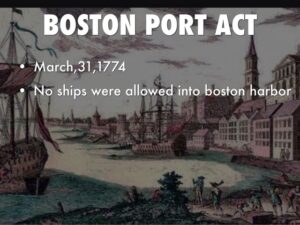 After the Boston Tea Party on December 16, 1773, the tensions between the British Parliament and the American Colonies seethed for months. Then, on March 25, 1774, the British Parliament took the next step in its reign of tyranny, when it passed the Boston Port Act. The Boston Port Act closed the port of Boston to all incoming and outgoing ships, while demanding that the city’s residents pay for the nearly $1 million worth (in today’s money) of tea dumped into Boston Harbor during the Boston Tea Party. The act basically held the city under siege, while demanding a ransom for its release.
After the Boston Tea Party on December 16, 1773, the tensions between the British Parliament and the American Colonies seethed for months. Then, on March 25, 1774, the British Parliament took the next step in its reign of tyranny, when it passed the Boston Port Act. The Boston Port Act closed the port of Boston to all incoming and outgoing ships, while demanding that the city’s residents pay for the nearly $1 million worth (in today’s money) of tea dumped into Boston Harbor during the Boston Tea Party. The act basically held the city under siege, while demanding a ransom for its release.
The Boston Port Act was the first and easiest to enforce of the four acts that resulted from the Boston Tea Party. Together, there were four acts, and they were known as the Coercive Acts. The other three were a new Quartering Act, the Administration of Justice Act, and the Massachusetts Government Act. These were passed as part of the Crown’s attempt to intimidate Boston’s increasingly unruly residents. King George III appointed General Thomas Gage, who commanded the British army in North America, as the new governor of Massachusetts in 1774, before the Massachusetts Government Act revoked the colony’s 1691 charter and curtailed the powers of the traditional town meeting and colonial council. Probably the biggest mistake the British made was in not understanding that the main reason the colonists left Britain was to get far enough away from Crown rule to live their own lives. These acts made it very clear to Bostonians that the crown intended to impose martial law, and that was something they just would not stand for.
Gage got right down to business, when in June, he easily sealed the ports of Boston and Charlestown using the formidable British navy. This act left merchants terrified of impending economic disaster. In their panic, many merchants simply wanted to pay for the tea and disband the Boston Committee of Correspondence, which had served to organize anti-British protests. Little did they know that to “bend their knees” to the tyranny would only have served to make matters worse. People make big mistakes when they get in fear. The merchants tried to convince their neighbors to appease the British in the hope of everything just “going away,” but that would never have been the case. A town meeting was called to discuss the matter, and the idea was immediately voted down by a substantial margin.
Parliament hoped that the Coercive Acts would isolate Boston from Massachusetts, Massachusetts from New England, and New England from the rest of North America, thereby preventing unified colonial resistance to the 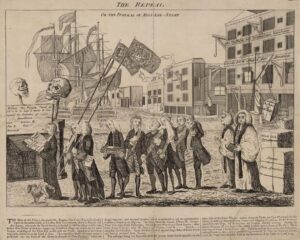
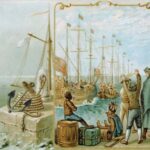 British. Again, they misjudged the colonists, and their effort backfired. Rather than abandon Boston, the colonial population shipped much-needed supplies to Boston and formed extra-legal Provincial Congresses to mobilize resistance to the crown. By the time Gage attempted to enforce the Massachusetts Government Act, his authority had eroded beyond repair. It was another “shot to the heart” of the crown, that would ultimately lead to their complete downfall.
British. Again, they misjudged the colonists, and their effort backfired. Rather than abandon Boston, the colonial population shipped much-needed supplies to Boston and formed extra-legal Provincial Congresses to mobilize resistance to the crown. By the time Gage attempted to enforce the Massachusetts Government Act, his authority had eroded beyond repair. It was another “shot to the heart” of the crown, that would ultimately lead to their complete downfall.

 Since moving from Powell, Wyoming to Butte, Montana has changed many things in my grandnephew, Weston Moore’s life. Weston is enjoying his life in Butte. He is working for a company that installs music sound systems in vehicle. This was a new line of work for Weston, and he is learning so much, and he can now figure out problems with electrical that we all dread on working on in vehicles!! He really enjoys the work, and his new life in Montana. Of course, with his family living so far away, he doesn’t get to see his parents, Steve and Machelle Moore and his brother, Easton Moore, as often as he used to. That makes it hard, and the weather in Montana and Wyoming doesn’t always make visiting home an easy thing to do.
Since moving from Powell, Wyoming to Butte, Montana has changed many things in my grandnephew, Weston Moore’s life. Weston is enjoying his life in Butte. He is working for a company that installs music sound systems in vehicle. This was a new line of work for Weston, and he is learning so much, and he can now figure out problems with electrical that we all dread on working on in vehicles!! He really enjoys the work, and his new life in Montana. Of course, with his family living so far away, he doesn’t get to see his parents, Steve and Machelle Moore and his brother, Easton Moore, as often as he used to. That makes it hard, and the weather in Montana and Wyoming doesn’t always make visiting home an easy thing to do. 
Nevertheless, Weston managed to get home for his brother’s graduation, Thanksgiving, and Christmas this year. Weston loves to surprise his family. They ask him when he might be coming home, and he does his best to make them think it will be a long while…and then he shows up. Weston loves it when they are all surprised to see him. Weston’s family was hoping to go to Butte for his birthday, but unfortunately, this trip is going have to wait a little while, because the car needs new tires, and it gets better gas milage. It’s a struggle for a lot of people this year. Hopefully prices go down so they can get together and do more things this summer.
While all this has made for an interesting year, it’s Weston, himself that is the biggest news. Weston has been working for a while now to become…less!! Weston decided that he wanted to lose weight and get healthy, so he set out to do just that. I’m not sure how long he has been working on it, but I can tell you that 100 pounds doesn’t come off overnight. Losing that kind of weight takes hard work and determination. Weston had made up his mind, and he wasn’t quitting until he succeeded. We are all so proud of his success. He looks great, and 
 he decided that to complete his transformation, he needed a haircut too. Well, he succeeded in a complete transformation, and I can happily say that today, we have less Weston. Today is Weston’s 23rd birthday. Happy birthday Weston!! Have a great day!! We love you and we’re so proud of you!!
he decided that to complete his transformation, he needed a haircut too. Well, he succeeded in a complete transformation, and I can happily say that today, we have less Weston. Today is Weston’s 23rd birthday. Happy birthday Weston!! Have a great day!! We love you and we’re so proud of you!!

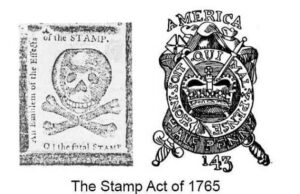 When this country was young, in fact, shortly before the Declaration of Independence was signed, and during a March 19, 1775, speech before the second Virginia Convention, Patrick Henry (39 years old) responded to the increasingly oppressive British rule over the American colonies by declaring, “I know not what course others may take, but as for me, give me liberty or give me death!” The speech so impressed so many people that following the signing of the American Declaration of Independence on July 4, 1776, Patrick Henry was appointed governor of Virginia by the Continental Congress. He couldn’t have fully known with the future might bring, but I think he might have had an inkling of what an oppressive government could potentially do to a nation. His words were a warning, not only to his generation, but to generations to come.
When this country was young, in fact, shortly before the Declaration of Independence was signed, and during a March 19, 1775, speech before the second Virginia Convention, Patrick Henry (39 years old) responded to the increasingly oppressive British rule over the American colonies by declaring, “I know not what course others may take, but as for me, give me liberty or give me death!” The speech so impressed so many people that following the signing of the American Declaration of Independence on July 4, 1776, Patrick Henry was appointed governor of Virginia by the Continental Congress. He couldn’t have fully known with the future might bring, but I think he might have had an inkling of what an oppressive government could potentially do to a nation. His words were a warning, not only to his generation, but to generations to come.
This young nation had been overtaxed, underrepresented, and in some ways enslaved, and they were done with it. The first major American opposition to British policy came in 1765 when Parliament passed the Stamp Act, which was a taxation measure to raise money for a standing British army in America. Basically, the Americans were being forced to pay for an army that was to keep them in line. That brought about the protest of “no taxation without representation,” and colonists convened the Stamp Act Congress in October 1765 to vocalize their opposition to the tax. With the enactment of the Stamp Act Congress on November 1, 1765, most colonists called for a boycott of British goods and organized attacks on the customhouses and homes of tax collectors. After months of protest, Parliament repealed the Stamp Act in March 1766. Their plan had worked.
Even with the taxation of the Stamp Act, most colonists quietly accepted British rule, thinking that it was best not to cause trouble, but when Parliament enacted the Tea Act in 1773, which granted the East India Company a monopoly on the American tea trade, the American people had had enough. The Tea Act was viewed as another way to gouge the people with unfair taxation, militant Patriots in Massachusetts organized a protest that became known as the “Boston Tea Party,” at which, protesters dumped British tea valued at approximately 10,000 pounds into Boston Harbor. Of course, the “Boston Tea Party” and other blatant destruction of British property absolutely enraged Parliament. They enacted the Coercive Acts, also known as the Intolerable Acts, in the following year. The Coercive Acts closed Boston to merchant shipping, established formal British military rule in Massachusetts, made British officials immune to criminal prosecution in America, and required colonists to quarter British troops. The oppressive, tyrannical rule just continued to grow worse. The British thought that if they could keep the colonists “under their thumb,” as it were, they could basically make slave workers out of them, and gouge them for the monies to keep Britain running smoothly. The colonists had other ideas, and so they called the first Continental Congress to consider a united American resistance to the British…finally!!
Massachusetts would lead the way of resistance against the British, with the other colonies watching intently. They formed a shadow revolutionary government and established militia groups to resist the increasing British military presence across the colony. Thomas Gage, the British governor of Massachusetts, ordered British 
 troops to march to Concord, Massachusetts in April 1775, where a Patriot arsenal was known to be located. On April 19, 1775, the British regulars encountered a group of American militiamen at Lexington, and the American Revolutionary War began. The fact was that Patrick Henry saw something that others did not see, that an out of control, oppressive government can be a terribly destructive force, if it is not held at bay.
troops to march to Concord, Massachusetts in April 1775, where a Patriot arsenal was known to be located. On April 19, 1775, the British regulars encountered a group of American militiamen at Lexington, and the American Revolutionary War began. The fact was that Patrick Henry saw something that others did not see, that an out of control, oppressive government can be a terribly destructive force, if it is not held at bay.
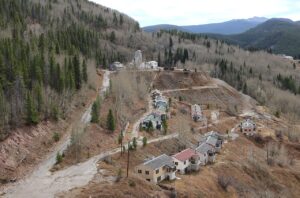 When corporate mining projects expanded and began to need a number of workers, the next logical step is to provide housing for the miners. By building a “company town” they could also control the rent, often making it necessary for the miners to spend all their wages, and even go into debt to get the things they needed to live. The “company town” of Gilman, Colorado was founded in 1886 during the Colorado Silver Boom, the town later became a center of lead and zinc mining in Colorado. The town was centered on the now-flooded Eagle Mine. When toxic pollutants, including contamination of the ground water in 1984, the town was abandoned by order of the Environmental Protection Agency. It was also due to unprofitability of the mines, meaning there was no longer a need for a “company town.”
When corporate mining projects expanded and began to need a number of workers, the next logical step is to provide housing for the miners. By building a “company town” they could also control the rent, often making it necessary for the miners to spend all their wages, and even go into debt to get the things they needed to live. The “company town” of Gilman, Colorado was founded in 1886 during the Colorado Silver Boom, the town later became a center of lead and zinc mining in Colorado. The town was centered on the now-flooded Eagle Mine. When toxic pollutants, including contamination of the ground water in 1984, the town was abandoned by order of the Environmental Protection Agency. It was also due to unprofitability of the mines, meaning there was no longer a need for a “company town.”
The town sat empty until 2007, when The Ginn Company began to make plans to build a private ski resort with private home sites across Battle Mountain, which would include development at the Gilman townsite. The Minturn Town Council, which held jurisdiction over Gilman, unanimously approved annexation and development 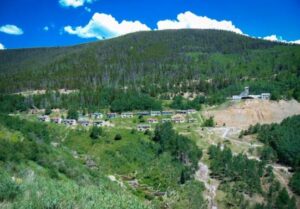 plans for 4,300 acres (6.7 square miles) of Ginn Resorts’ 1,700-unit Battle Mountain residential ski and golf resort, on February 27, 2008. Ginn’s Battle Mountain development would also include much of the old Gilman townsite. I’m not sure how I feel about that. To restore an old structure for a similar use is one thing, but to make it a ski resort seems wrong somehow. Then again, I guess as housing, it probably wouldn’t have been in the proper location to use as housing. On May 20, 2008, the town of Minturn approved the annexation in a public referendum with 87% of the vote. Then, as of September 9, 2009, the Ginn Company backed out of development plans for the Battle Mountain Property, so once again the site will be left to decay. Crave Real Estate Ventures, who was the original finance to Ginn, took over day to day operations of the property. For now, and the foreseeable future, Gilman is a ghost town on private property and is strictly off limits to the public.
plans for 4,300 acres (6.7 square miles) of Ginn Resorts’ 1,700-unit Battle Mountain residential ski and golf resort, on February 27, 2008. Ginn’s Battle Mountain development would also include much of the old Gilman townsite. I’m not sure how I feel about that. To restore an old structure for a similar use is one thing, but to make it a ski resort seems wrong somehow. Then again, I guess as housing, it probably wouldn’t have been in the proper location to use as housing. On May 20, 2008, the town of Minturn approved the annexation in a public referendum with 87% of the vote. Then, as of September 9, 2009, the Ginn Company backed out of development plans for the Battle Mountain Property, so once again the site will be left to decay. Crave Real Estate Ventures, who was the original finance to Ginn, took over day to day operations of the property. For now, and the foreseeable future, Gilman is a ghost town on private property and is strictly off limits to the public.
While it is illegal to go into the town, aerial views of it can still give an idea of what the town looked like. It makes me rather sad that people can’t go in and explore the old “company town” anymore, but I suppose they would need to decide it’s future before allowing the public to have access. Unfortunately, the public came be a 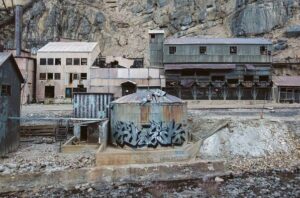 destructive force when it is turned loose on ruins. Right now, the townsite is a victim of vandalism, and the town’s main street is heavily tagged with graffiti. There are only a few intact windows left in town, as twenty years of vandalism have left almost every glass object in the town destroyed. Still, there are many parts of the town are almost as they were when the mine shut down. The main shaft elevators still sit ready for ore cars, permanently locked at the top level. Several cars and trucks still sit in their garages, left behind by their owners. Because of its size, modernity and level of preservation, the town is also the subject of interest for many historians, explorers, and photographers. I guess, “off limits to the public” doesn’t mean much.
destructive force when it is turned loose on ruins. Right now, the townsite is a victim of vandalism, and the town’s main street is heavily tagged with graffiti. There are only a few intact windows left in town, as twenty years of vandalism have left almost every glass object in the town destroyed. Still, there are many parts of the town are almost as they were when the mine shut down. The main shaft elevators still sit ready for ore cars, permanently locked at the top level. Several cars and trucks still sit in their garages, left behind by their owners. Because of its size, modernity and level of preservation, the town is also the subject of interest for many historians, explorers, and photographers. I guess, “off limits to the public” doesn’t mean much.
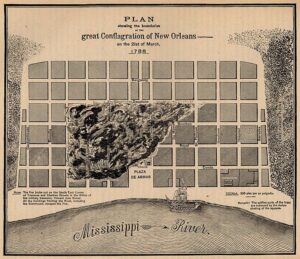
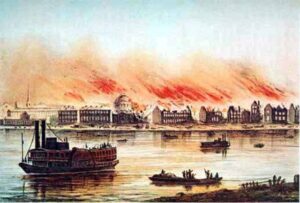 I don’t know what kind of a city New Orleans was in 1788, but much of it changed that year, because on March 21, 1788, the first of two great fires left the city in ruins. There are a number of ways to destroy a city…time, storms, neglect, need, and the worst one, fire. Were it not for two great fires, there might be more of colonial New Orleans left for people to enjoy. Unfortunately, two great fires in the late eighteenth century left New Orleans and its inhabitants very few years to re-establish their institutions before the onset of American domination in 1803, making the city more American than French. Today, there are several fine houses that date to the last colonial decade, as well as the French Quarter, including the Cabildo and the Presbytere, but they are “post-fire” nevertheless.
I don’t know what kind of a city New Orleans was in 1788, but much of it changed that year, because on March 21, 1788, the first of two great fires left the city in ruins. There are a number of ways to destroy a city…time, storms, neglect, need, and the worst one, fire. Were it not for two great fires, there might be more of colonial New Orleans left for people to enjoy. Unfortunately, two great fires in the late eighteenth century left New Orleans and its inhabitants very few years to re-establish their institutions before the onset of American domination in 1803, making the city more American than French. Today, there are several fine houses that date to the last colonial decade, as well as the French Quarter, including the Cabildo and the Presbytere, but they are “post-fire” nevertheless.
The French Quarter of today is very different from what it once was, and it makes me wonder what it might have been like before. These days, the French Quarter receives millions of visitors annually, and it’s hard to imagine the carnage of the fire of Holy Saturday morning in 1788. The fire was devastating, with smoking ruins stretching from Chartres to Dauphine Street, and from Conti to Saint Philip. The fire actually began on Good Friday morning in the home of Spanish treasurer Don Vincente Nunez at Toulouse and Chartres. The wind was blowing out of the southeast bringing in a blustery cold front. The wind, combined with the fire, reduced over eight hundred homes and public buildings to ashes in a matter of hours. The church, the town hall, and the rectory on the Plaza de Armas were suddenly gone. Governor Esteban Miro told Spanish authorities of the “abject misery, crying, and sobbing” of the people. He wrote that the faces of the families, “told the ruin of a city which in less than five hours has been transformed into an arid and horrible wilderness; the work of seventy years since its foundation.”
The rebuilding of the city began right away, but had barely started when, in 1794 a second fire and two hurricanes swept the city. It seemed that New Orleans was doomed to devastation. The December 8, 1794, fire burned 212 buildings…fewer than the prior fire, but these buildings were more valuable. After the two storms and both fires were done, nearly all the public buildings, homes and businesses, except those fronting the river had been reduced to ashes or badly damaged. Through it all the Ursuline nuns in their convent on Chartres Street had prayed over their hometown, and as the fire got close to the convent on that Good Friday, the wind suddenly shifted. Miraculously, the convent survived and still stands today.
The French Quarter was essentially changed forever. “Baked tile and quarried slate replaced the roofs of ax-hewn cypress shingles. Buildings, set at the sidewalk or banquette, were of all brick, with common firewalls. The wide and shallow hipped roof, galleried townhouse perfected in the French period gave way to vertical, long and narrow Spanish-style town homes, many with overhangs, iron work and entresols or mezzanines. The Cabildo and Presbytere came into being. A new church rose from the ashes. A suburb opened on the upper side of town for residents wary of crowded Quarter conditions. Fire pumps were commissioned. The market moved riverside. Artisans were called in. Protestants gained a foothold. But people went homeless, the city indebted, and lives were lost to death or removal. The city was different.”
Since 1794, the French Quarter has been spared large fires, although there have been some smaller fires, and the hurricanes kept coming. They are just common to the area. A great storm that took place on August 19, 1812, swept away a one-year-old French Market building. Another in 1915 damaged the steeple of Saint Louis Cathedral. A fire in September 1816 took the popular Orleans Theater and Orleans Ballroom. Then, the rebuilt theater burned again in 1866. Fire damaged the Bank of Louisiana on Royal Street resulting in the monumental columns installed in the remodeling, which is now the home of the Vieux Carré Commission.
These devastating losses have resulted in a stringent French Quarter fire code. No longer is the Mardi Gras 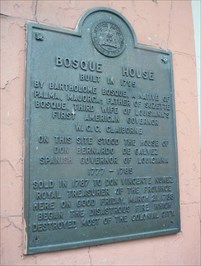
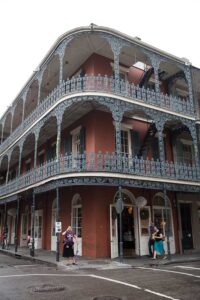 parade allowed to be motorized. The city takes prevention very seriously, knowing that fire spreading would be devastating to the French Quarter and to the city as a whole. Even with every precaution, the most important fires of the Twentieth Century occurred at individual structures. It is thought, by some historians, that the burning of the Old French Opera House on Bourbon, in 1919, was the “final nail” in the coffin of the old Creole culture in the Quarter, while others adopted that culture, thereby keeping its memory alive. Then, when the Cabildo burned in 1988, two hundred years after the First Great Fire, the citizens of the city felt the loss deeply. The structure was carefully restored, and it stands as a proud reminder of a city’s resolve to safeguard its heritage to this day.
parade allowed to be motorized. The city takes prevention very seriously, knowing that fire spreading would be devastating to the French Quarter and to the city as a whole. Even with every precaution, the most important fires of the Twentieth Century occurred at individual structures. It is thought, by some historians, that the burning of the Old French Opera House on Bourbon, in 1919, was the “final nail” in the coffin of the old Creole culture in the Quarter, while others adopted that culture, thereby keeping its memory alive. Then, when the Cabildo burned in 1988, two hundred years after the First Great Fire, the citizens of the city felt the loss deeply. The structure was carefully restored, and it stands as a proud reminder of a city’s resolve to safeguard its heritage to this day.
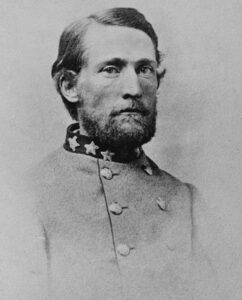 John Singleton Mosby was a Confederate army cavalry battalion commander in the American Civil War. He was also known as “The Gray Ghost.” Mosby’s command, the 43rd Battalion of the Virginia Cavalry was known as Mosby’s Rangers or Mosby’s Raiders. The Unit was a partisan ranger unit noted for its lightning-quick raids and its ability to elude Union Army pursuers and disappear, blending in with local farmers and townsmen. They were so quick and so skilled, that they practically vanished into thin air. Mosby was a legend, and the area of northern central Virginia soon became known as Mosby’s Confederacy. When the war was over, Mosby went on to become a Republican and worked as an attorney, supporting his former enemy’s commander, US President Ulysses S Grant. His political career took him to the US Department of Justice, where he served as the American consul to Hong Kong.
John Singleton Mosby was a Confederate army cavalry battalion commander in the American Civil War. He was also known as “The Gray Ghost.” Mosby’s command, the 43rd Battalion of the Virginia Cavalry was known as Mosby’s Rangers or Mosby’s Raiders. The Unit was a partisan ranger unit noted for its lightning-quick raids and its ability to elude Union Army pursuers and disappear, blending in with local farmers and townsmen. They were so quick and so skilled, that they practically vanished into thin air. Mosby was a legend, and the area of northern central Virginia soon became known as Mosby’s Confederacy. When the war was over, Mosby went on to become a Republican and worked as an attorney, supporting his former enemy’s commander, US President Ulysses S Grant. His political career took him to the US Department of Justice, where he served as the American consul to Hong Kong.
Mosby was born to Virginia McLaurine Mosby and Alfred Daniel Mosby in Powhatan County, Virginia, on December 6, 1833. He was a graduate of Hampden–Sydney College. Mosby’s father was a member of an old Virginia family of English origin whose ancestor, Richard Mosby, 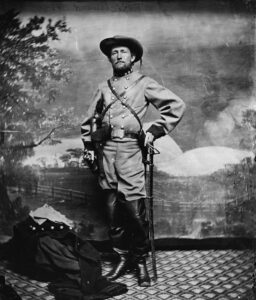 was born in England in 1600. The family settled in Charles City, Virginia in the early 17th century. Young Mosby was named after his maternal grandfather, John Singleton, who was ethnically Irish.
was born in England in 1600. The family settled in Charles City, Virginia in the early 17th century. Young Mosby was named after his maternal grandfather, John Singleton, who was ethnically Irish.
While Mosby was a hero in some ways and a politician, there was another side of him too. Mosby was a Confederate battalion commander, yes, but he was known for his guerrilla military tactics. One of his biggest victories of the war found him and 29 of his men infiltrating the area surrounding the Fairfax County Courthouse in the middle of the night. They caught the Union officers completely off-guard, because they were 10 miles safe behind Union lines. The situation gave Mosby the opportunity he needed. He had captured a general, 30 other Union soldiers, and nearly 60 horses, which was already an incredibly valuable take during the war. In addition, Mosby decided to treat himself, and maybe or maybe not his men, to many of the Union men’s valuables, gathering quite a treasure for himself.
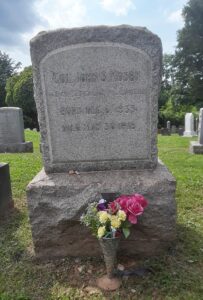
While they were taking their prisoners into Confederate territory, they were informed about Union troops in the area. Mosby decided that he needed to protect his goods. So, he left the group and buried his treasure between two trees. He marked the spot with an X. As sometimes happened, Mosby switched sides politically, and personally, after the war. He chose to support Lincoln and even went on to serve on President Grant’s administration. So, what of the treasure? Well, apparently Mosby never retrieved the treasure he pillaged. Some people reported that he sent Confederate soldiers to dig it up, but they were caught and killed by Union soldiers. And if that was the case, either they hadn’t started digging yet, or hadn’t made it to the location yet, because to this day, the treasure has never been found. I guess he took the location to his grave. John S Mosby died of complications after throat surgery in a Washington, DC hospital on May 30, 1916, noting at the end that it was Memorial Day. He is buried at the Warrenton Cemetery in Warrenton, Virginia.
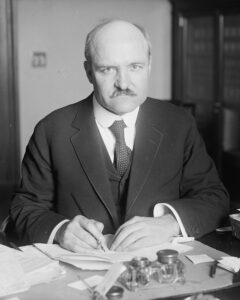 No matter what your opinion is on the use of Daylight Savings Time and Standard Time, the was originally a good reason for it, and that reason still applies today in many ways. The Standard Time Act of 1918, which was also known as the Calder Act (after the senator who sponsored the bill…William M. Calder), was the first United States federal law implementing Standard time and Daylight Saving Time in the United States. Prior to the Calder Act, the railroads had instituted time zones so that the rail schedule could have much needed consistency. Before time zones, no one had any idea when the train was due. It was a big mess. The Time Zone system defined five time zones for the United States and authorized the Interstate Commerce Commission to define the limits of each time zone.
No matter what your opinion is on the use of Daylight Savings Time and Standard Time, the was originally a good reason for it, and that reason still applies today in many ways. The Standard Time Act of 1918, which was also known as the Calder Act (after the senator who sponsored the bill…William M. Calder), was the first United States federal law implementing Standard time and Daylight Saving Time in the United States. Prior to the Calder Act, the railroads had instituted time zones so that the rail schedule could have much needed consistency. Before time zones, no one had any idea when the train was due. It was a big mess. The Time Zone system defined five time zones for the United States and authorized the Interstate Commerce Commission to define the limits of each time zone.
When the need for Daylight Savings Time came up, the original point of it was to save fuel by setting working hours so they coincided with the hours of natural daylight. While many people may not like that much, I think that a sensible person  can at least see the purpose of it. The act included a section that talked about the repeal of the change in one year, but in the end, it was decided that it was necessary to continue the practice. In fact, they could see no usefulness in repealing it, because the fuel savings had not changed. So, the practice has continued to this day. The Calder Act came about in answer to the European countries, who were already using the practice successfully.
can at least see the purpose of it. The act included a section that talked about the repeal of the change in one year, but in the end, it was decided that it was necessary to continue the practice. In fact, they could see no usefulness in repealing it, because the fuel savings had not changed. So, the practice has continued to this day. The Calder Act came about in answer to the European countries, who were already using the practice successfully.
Those who dislike the practice have been trying to repeal the act for as long as I can remember anyway, and with no success. I suppose that someday, they may succeed, but I’m not sure they will find that life without the time changes will be as amazing as they think. The sun will continue to make its  seasonal adjustments, and without the time changes, we will at some point, find ourselves wishing for another hour of daylight. The first time change to Daylight Saving Time took place on March 19, 1918, and it has been in practice since that time. I, personally, look forward to Daylight Saving Time every year. The longer days and more light make me feel happy, and I find that the few days or a week of adjustment is of little consequence in the grand scheme of things. Nevertheless, I’m sure I’ll hear lots of differing opinions from my readers. This year, Daylight Saving Time started on March 12, and Standard Time will begin on November 5…just so you know.
seasonal adjustments, and without the time changes, we will at some point, find ourselves wishing for another hour of daylight. The first time change to Daylight Saving Time took place on March 19, 1918, and it has been in practice since that time. I, personally, look forward to Daylight Saving Time every year. The longer days and more light make me feel happy, and I find that the few days or a week of adjustment is of little consequence in the grand scheme of things. Nevertheless, I’m sure I’ll hear lots of differing opinions from my readers. This year, Daylight Saving Time started on March 12, and Standard Time will begin on November 5…just so you know.
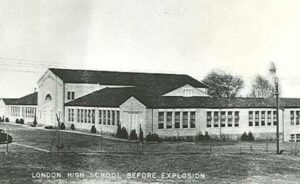 Years ago, when natural gas was first being used for energy, it had no odor, and so, if there was a leak, there was no warning. Natural gas was considered safe, and for the most part, it was, but when it leaked, and fumes pooled, any spark could be deadly. There is another kind of natural gas, called wet-gas that is less stable that natural gas, and probably should never have been used, but in the 1930s, the dangers were less known. Natural gas was more expensive, so sometimes consumers…mostly large consumers opted for the cheaper wet-gas to save a little money.
Years ago, when natural gas was first being used for energy, it had no odor, and so, if there was a leak, there was no warning. Natural gas was considered safe, and for the most part, it was, but when it leaked, and fumes pooled, any spark could be deadly. There is another kind of natural gas, called wet-gas that is less stable that natural gas, and probably should never have been used, but in the 1930s, the dangers were less known. Natural gas was more expensive, so sometimes consumers…mostly large consumers opted for the cheaper wet-gas to save a little money.
The Consolidated School of New London, Texas actually sat in the middle of a large oil and natural gas field. Texas is known for its oil and natural gas fields, and it wasn’t uncommon for towns to be build right in the middle of the fields. The area of New London was dominated by 10,000 oil derricks, 11 of which stood right on school grounds. The school, costing close to $1 million, was newly built in the 1930s and, from its inception, it bought natural gas from Union Gas to supply its energy needs. The school’s monthly natural gas bill averaged about $300 a month, and with such an exorbitant bill, the school officials were eventually persuaded to save money by switching over to the wet-gas lines, which were operated by Parade Oil Company. The lines ran near the school, and the cost to use them was definitely less. Wet-gas is a type of waste gas that has more impurities than typical natural gas and wasn’t as safe. Still, at the time, it wasn’t uncommon for consumers living near oil fields to use this gas.
On March 18, 1937, at approximately 3:05pm, a Thursday afternoon, school was about to end for the day, and 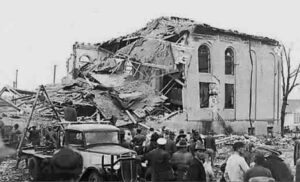 the 694 students and 40 teachers at the Consolidated School were waiting for the final bell, which was to ring in 10 minutes. It was not the final bell that was heard, but rather a huge explosion and powerful explosion shook the region. The blast literally blew the roof off of the building, leveled the school. There was no warning, because back then, natural gas was odorless. Nevertheless, in the presence of the leaking fumes, a single spark…or even static electricity, had the ability to create an explosion of indescribable proportions…and that is exactly what happened. When the blast came, it could be felt 40 miles away and most of the victims were killed instantly. From all over town, and even the surrounding towns, rescue workers and even everyday citizens rushed to the scene to pull out survivors. Surprisingly, hundreds of injured students were hauled from the rubble, and some students miraculously walked away unharmed. Ten students were found under a large bookcase that, when it fell, actually shielded them from the falling building. The rescue workers quickly established first-aid stations in the nearby towns of Tyler, Overton, Kilgore, and Henderson to tend to the wounded. It was noted that a blackboard at the destroyed school was found that read, “Oil and natural gas are East Texas’ greatest natural gifts. Without them, this school would not be here and none of us would be learning our lessons.” Yes, they were, but they could also be the greatest danger.
the 694 students and 40 teachers at the Consolidated School were waiting for the final bell, which was to ring in 10 minutes. It was not the final bell that was heard, but rather a huge explosion and powerful explosion shook the region. The blast literally blew the roof off of the building, leveled the school. There was no warning, because back then, natural gas was odorless. Nevertheless, in the presence of the leaking fumes, a single spark…or even static electricity, had the ability to create an explosion of indescribable proportions…and that is exactly what happened. When the blast came, it could be felt 40 miles away and most of the victims were killed instantly. From all over town, and even the surrounding towns, rescue workers and even everyday citizens rushed to the scene to pull out survivors. Surprisingly, hundreds of injured students were hauled from the rubble, and some students miraculously walked away unharmed. Ten students were found under a large bookcase that, when it fell, actually shielded them from the falling building. The rescue workers quickly established first-aid stations in the nearby towns of Tyler, Overton, Kilgore, and Henderson to tend to the wounded. It was noted that a blackboard at the destroyed school was found that read, “Oil and natural gas are East Texas’ greatest natural gifts. Without them, this school would not be here and none of us would be learning our lessons.” Yes, they were, but they could also be the greatest danger.
The investigators were never able to determine the exact cause of the spark that ignited the gas, noting that it very well may have been simple static electricity. Sadly, the dangers of wet-gas came more to light because of this incident, and as a result wet gas was required to be burned at the site rather than piped away. Also, as a safety precaution, a new state law was put into place, mandating the usage of malodorants in natural gas for 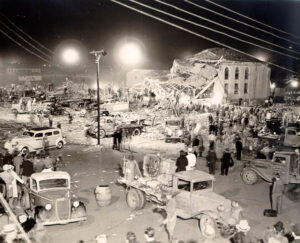 commercial and industrial use. This would provide a warning to anyone in the area of a natural gas leak, and hopefully prevent large casualties such as the ones felt in this explosion. The number of people estimated killed in the explosion is 294, but the actual number of victims remains unknown. The majority were from grades five through eleven, because the younger students were educated in a separate building, and most of them had already been dismissed from school. Many of the victims were only identified by their clothing or fingerprints, which was only available because many inhabitants of the surrounding area had been fingerprinted at the Texas Centennial Exposition the previous summer. Who could have known the importance of that exposition?
commercial and industrial use. This would provide a warning to anyone in the area of a natural gas leak, and hopefully prevent large casualties such as the ones felt in this explosion. The number of people estimated killed in the explosion is 294, but the actual number of victims remains unknown. The majority were from grades five through eleven, because the younger students were educated in a separate building, and most of them had already been dismissed from school. Many of the victims were only identified by their clothing or fingerprints, which was only available because many inhabitants of the surrounding area had been fingerprinted at the Texas Centennial Exposition the previous summer. Who could have known the importance of that exposition?
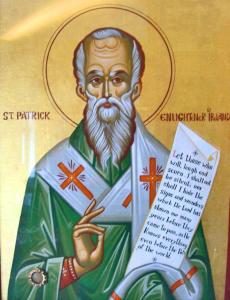 Today is Saint Patrick’s Day, but I don’t believe in Luck. I believe in blessed. Saint Patrick’s Day celebrations are all about “the luck” of the Irish. I’m not real sure where that idea got started, and I know that it’s all in fun, but luck isn’t real, and blessing is. Saint Patrick was born in Britain, but he was kidnapped by Irish pirates at 16 and enslaved for six years. They took him to Ireland where he was enslaved and held captive for six years. Patrick writes in the Confession that “the time he spent in captivity was critical to his spiritual development.” Often it is when we are our lowest time, that we finally look up and find the Lord. He explains that “the Lord had mercy on his youth and ignorance and afforded him the opportunity to be forgiven his sins and convert to Christianity.” While Saint Patrick was held in captivity, he was assigned to work as a shepherd, but while there, he also strengthened his relationship with God through prayer, eventually leading him to convert to Christianity.
Today is Saint Patrick’s Day, but I don’t believe in Luck. I believe in blessed. Saint Patrick’s Day celebrations are all about “the luck” of the Irish. I’m not real sure where that idea got started, and I know that it’s all in fun, but luck isn’t real, and blessing is. Saint Patrick was born in Britain, but he was kidnapped by Irish pirates at 16 and enslaved for six years. They took him to Ireland where he was enslaved and held captive for six years. Patrick writes in the Confession that “the time he spent in captivity was critical to his spiritual development.” Often it is when we are our lowest time, that we finally look up and find the Lord. He explains that “the Lord had mercy on his youth and ignorance and afforded him the opportunity to be forgiven his sins and convert to Christianity.” While Saint Patrick was held in captivity, he was assigned to work as a shepherd, but while there, he also strengthened his relationship with God through prayer, eventually leading him to convert to Christianity.
After six years of captivity, Patrick heard a voice telling him in a dream that he would soon go home, and then that his ship was ready. There was no “luck” to it. God spoke to him in a dream, and he obeyed. He was blessed with his freedom. He immediately took action, and escaping from his master, he  travelled to a port, two hundred miles away. Once there, Patrick found a ship and with difficulty persuaded the captain to take him. After three days of sailing, they landed, presumably in Britain. Odd that they didn’t seem to know. All the passengers and crew left the ship, walking for 28 days in a “wilderness” and almost starving to death. After Patrick prayed for sustenance, they encountered a herd of wild boar, and since this was shortly after Patrick had urged them to put their faith in God, his reputation as a man of God grew. By the time Patrick arrived back to his family, he was a young man of twenty years. Patrick continued to study Christianity.
travelled to a port, two hundred miles away. Once there, Patrick found a ship and with difficulty persuaded the captain to take him. After three days of sailing, they landed, presumably in Britain. Odd that they didn’t seem to know. All the passengers and crew left the ship, walking for 28 days in a “wilderness” and almost starving to death. After Patrick prayed for sustenance, they encountered a herd of wild boar, and since this was shortly after Patrick had urged them to put their faith in God, his reputation as a man of God grew. By the time Patrick arrived back to his family, he was a young man of twenty years. Patrick continued to study Christianity.
After making his escape, Saint Patrick, who wasn’t a saint then, made his way back to Britain, but Ireland beckoned him, and he would eventually go back there. Patrick had a vision a few years after returning home, “I saw a man coming, as it were from Ireland. His name was Victoricus, and he carried many letters, and he gave 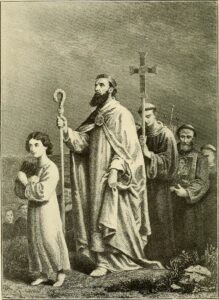 me one of them. I read the heading: ‘The Voice of the Irish,’ As I began the letter, I imagined in that moment that I heard the voice of those very people who were near the wood of Foclut, which is beside the western sea, and they cried out, as with one voice: ‘We appeal to you, holy servant boy, to come and walk among us.'” A.B.E. Hood suggests that the Victoricus of Saint Patrick’s vision may be identified with Saint Victricius, bishop of Rouen in the late fourth century, who had visited Britain in an official capacity in 396. However, Ludwig Bieler disagrees. I guess we will ever really know.
me one of them. I read the heading: ‘The Voice of the Irish,’ As I began the letter, I imagined in that moment that I heard the voice of those very people who were near the wood of Foclut, which is beside the western sea, and they cried out, as with one voice: ‘We appeal to you, holy servant boy, to come and walk among us.'” A.B.E. Hood suggests that the Victoricus of Saint Patrick’s vision may be identified with Saint Victricius, bishop of Rouen in the late fourth century, who had visited Britain in an official capacity in 396. However, Ludwig Bieler disagrees. I guess we will ever really know.
Acting on his vision, Patrick returned to Ireland as a Christian missionary, and that is how he became a patron saint of Ireland. Saint Patrick actually never used a four-leaf clover, but rather he used a three-leaf clover as a way to help people to understand the Trinity (Triune God – Father, Son, and Holy Spirit).

